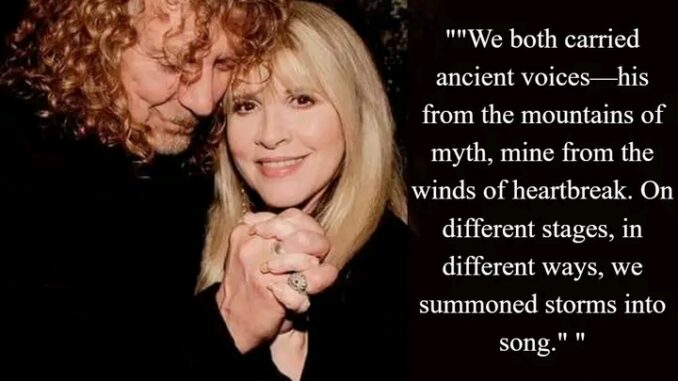
Robert Plant and Stevie Nicks, though from separate bands—Led Zeppelin and Fleetwood Mac—are often linked by their mystical personas and evocative vocals. Plant’s soaring vocals on tracks like “Immigrant Song” and “Ramble On” from Zeppelin’s 1970s albums shaped hard rock. Nicks, joining Fleetwood Mac in 1975, brought a poetic edge to albums like Rumours (1977) and Tusk (1979). Her solo albums like Bella Donna (1981) highlighted her ethereal presence. While they never formally collaborated, their mutual respect and similar artistic aura often sparked fan comparisons. Both artists remain symbols of rock’s poetic and powerful side, influencing generations of singers.
Certainly! Here’s an expanded 800-word essay exploring Robert Plant and Stevie Nicks, their careers, artistic personas, and their mutual influence in rock music:
—
**Robert Plant and Stevie Nicks: Mystical Voices of Rock**
Though originating from different bands—Robert Plant from Led Zeppelin and Stevie Nicks from Fleetwood Mac—these two iconic artists are often linked through their mystical personas, evocative vocals, and profound influence on rock music. Their careers, marked by poetic lyricism, powerful singing, and a commanding stage presence, have shaped the soundscape of their respective eras and continue to inspire generations of musicians and fans alike.
**The Rise of Robert Plant: A Voice of Hard Rock**
Robert Plant emerged in the late 1960s as the lead singer of Led Zeppelin, a band that would redefine hard rock and heavy metal. With his soaring vocals, Plant infused their music with a sense of mysticism and grandeur that set them apart. Tracks like “Immigrant Song” and “Ramble On” exemplify his ability to blend raw power with lyrical poeticism.
“Immigrant Song,” released in 1970 on the album *Led Zeppelin III*, features Plant’s high-pitched wail and mythic lyrics inspired by Norse mythology and Viking imagery. Its driving rhythm and primal energy captured the spirit of exploration and rebellion. Similarly, “Ramble On” from the 1969 album *Led Zeppelin II* showcases his storytelling prowess, weaving themes of love, loss, and fantasy into a memorable melody. Plant’s vocals are characterized by their dynamic range, from delicate whispers to thunderous roars, creating an emotional and visceral experience for listeners.
Led Zeppelin’s sound was groundbreaking—combining blues, folk, psychedelia, and hard rock—yet it was Plant’s commanding presence and mystical lyricism that became its defining feature. His persona was imbued with an almost shamanic aura, often drawing on mythic and mystical imagery that resonated with fans seeking transcendence through music.
**Stevie Nicks: The Ethereal Songstress**
Meanwhile, Stevie Nicks joined Fleetwood Mac in 1975, bringing a poetic and mystical sensibility to the band’s evolving sound. Her distinctive voice—airy, sultry, and emotionally charged—became one of the defining elements of Fleetwood Mac’s sound during their peak years.
Nicks’s songwriting and vocals on albums like *Rumours* (1977) and *Tusk* (1979) showcased her ability to craft deeply personal and poetic lyrics. Songs like “Dreams,” “Landslide,” and “Rhiannon” are laced with mystical imagery and introspective themes. “Rhiannon,” inspired by Welsh mythology and folklore, exemplifies her fascination with mysticism and the spiritual realm. Her lyrics often explore themes of love, loss, and self-awareness, wrapped in poetic language that invites listeners into an introspective journey.
Her stage presence complemented her ethereal vocal style—clad in flowing dresses, often adorned with feathers and mystical accessories—Nicks projected an aura of otherworldliness. Her persona became emblematic of a poetic, mystical side of rock—someone who embodied the spirit of free-spiritedness and introspection.
**Parallel Artistic Legacies**
Despite their different musical styles—Plant’s hard-driving rock and Nicks’s poetic soft rock—they share a common artistic aura rooted in mysticism, poetic lyricism, and a commanding vocal presence. Both artists brought a sense of theatricality and emotional depth to their performances, elevating rock music beyond mere entertainment to an art form that explores the human condition.
Their mutual respect is well-documented. While they never officially collaborated on a song, their influence on each other’s work and their fans’ perceptions have often led to comparisons. Both artists have spoken highly of each other’s talents, recognizing the mystical qualities and lyrical depth each brings to their music.
**Influence and Legacy**
Robert Plant’s soaring vocals and mythic lyricism helped define Led Zeppelin’s legacy as pioneers of hard rock and heavy metal. His vocal innovation and charismatic stage presence set a template for rock frontmen that followed. His influence extends to countless singers who admire his ability to combine raw power with poetic storytelling.
Stevie Nicks, on the other hand, became a symbol of poetic femininity and mystical artistry in rock. Her influence is evident in the way she merged poetic lyricism with a unique vocal style, inspiring artists across genres. Her solo albums, like *Bella Donna* (1981), showcased her ability to stand out as a solo artist while retaining her mystical aura. Nicks’s influence can be seen in the rise of singer-songwriters and artists who seek to blend spirituality and poetic storytelling into their music.
Both artists have also become symbols of empowerment and individualism. Their personas challenged conventional notions of femininity and masculinity in rock, paving the way for future generations of artists to express their identities freely.
**Conclusion**
Robert Plant and Stevie Nicks exemplify the mystical and poetic side of rock music. Their distinct voices—Plant’s commanding, mythic wail and Nicks’s ethereal, poetic tone—have left indelible marks on the genre. Rooted in their shared affinity for mysticism, lyrical depth, and powerful performance, they continue to inspire musicians and fans worldwide. Their legacies remind us that rock music can be a transcendental art form—one that elevates the soul through poetic storytelling and evocative soundscapes. Though from different bands and eras, their artistry remains intertwined as symbols of rock’s poetic, powerful, and mystical spirit.
—
Would you like me to expand further on any specific aspect or provide additional details?
Leave a Reply